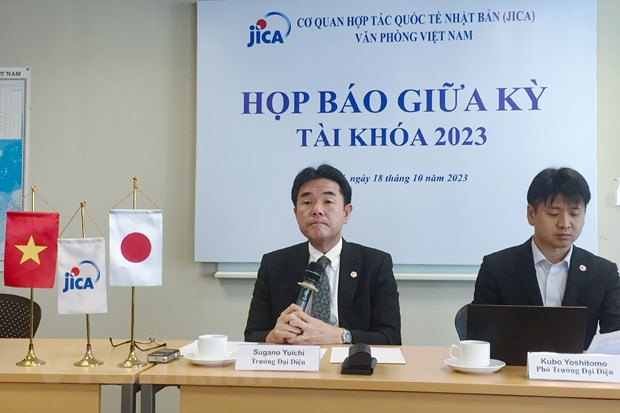Japan pledges JPY18.9 billion in ODA to Viet Nam in 2022-2023 fiscal year
VGP - Japan’s total official development assistance (ODA) commitment to Viet Nam from April 2022 to March 2023 amounts to JPY18.9 billion (US$126 million), excluding loans to the private sector.

Mr. Sugano Yuichi (L), Chief Representative of Japan International Cooperation Agency (JICA)-Viet Nam Office at a mid-term press conference, Ha Noi, October 18, 2023 - Photo: VNA
Mr. Sugano Yuichi, Chief Representative of Japan International Cooperation Agency (JICA)-Viet Nam Office released the figure at a mid-term press conference held in Ha Noi on October 18.
Specifically, the total value of ODA capital for technical cooperation projects and non-refundable aid projects in the country reached JPY4.7 billion and JPY0.7 billion, respectively, with more than 100 large and small projects being underway, he added.
Regarding JICA Viet Nam's activities in the fiscal year 2023, Yuichi said a prominent result was the ODA loan agreement signed in July for three projects, with a total value of over JPY 60 billion (US$400 million).
The loan agreement focuses on three areas, including renovating urban public transportation infrastructure; strengthening agricultural supply chains; and post-COVID-19 economic and social recovery and development.
This marks the most ODA loan agreements signed simultaneously since 2017.
Four cooperation priorities
Looking forward, JICA's key areas of cooperation in Viet Nam include high-quality infrastructure development, with ongoing projects such as the Binh Duong Urban Public Transportation Infrastructure Renovation in southern Binh Duong province and the Infrastructure Improvement Project for Agricultural Development in the Central Highlands' Lam Dong province.
Progress in the Ho Chi Minh City Urban Railway (Metro Line No. 1) is also promising, with a 96 per cent completion rate and operations expected to commence in July 2024.
Additionally, JICA is actively involved in human resources development, facilitating skilled internships in Japan and conducting training programs for industrial workforce enhancement.
In the health sector, JICA is aiding in establishing a remote training system to upgrade healthcare capabilities, especially focusing on addressing emerging health challenges like population aging.
Lastly, JICA's initiatives in climate change adaptation involve renewable energy projects and contributions to the Green Climate Fund, aligning with Viet Nam's target of achieving carbon neutrality by 2050./.
